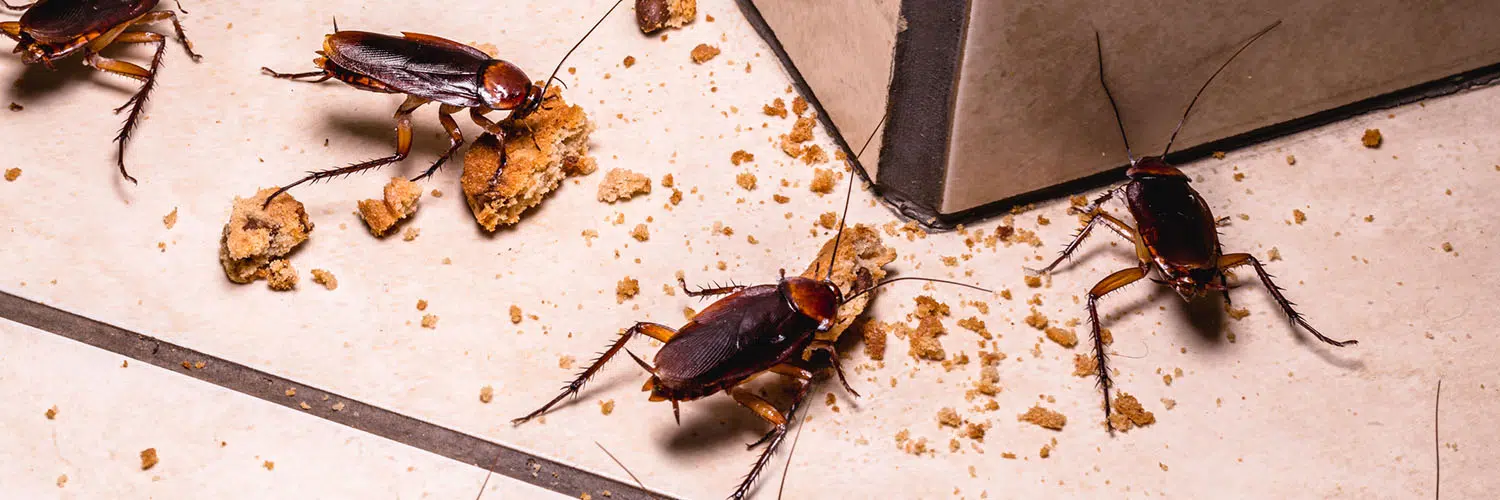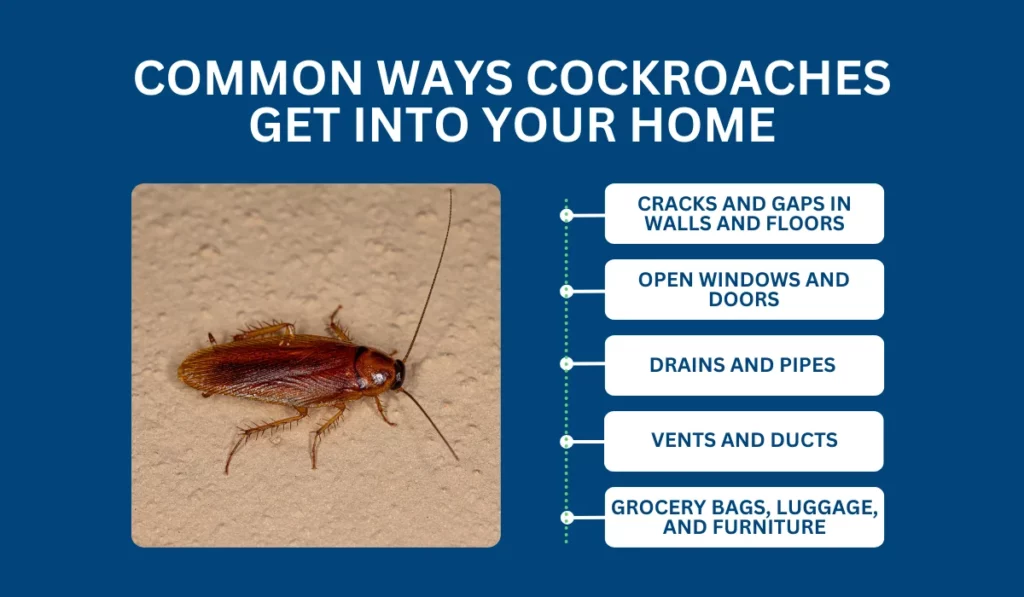Cockroach Treatments in Florida:
Exterminator Services for Cape Coral and North Fort Myers
Florida’s subtropical climate, characterized by mild winters, abundant warmth, and steady humidity, provides an attractive setting for many organisms – including cockroaches. These adaptable pests can move into homes, restaurants, or commercial buildings and quickly settle if conditions allow. Whether you manage a bustling waterfront property in Cape Coral or a home in North Fort Myers, overlooking the initial presence of roaches can lead to hygiene concerns, contaminations, and ongoing stress. This service page explains why cockroaches proliferate so readily in Florida, how to identify warning signs of an infestation, and how enlisting a professional cockroach exterminator for comprehensive cockroach treatments offers an effective, lasting solution. By understanding roach behavior and responding swiftly, you can block major infestations, safeguard health, and preserve the comfort of your living or working environment.
Why Cockroaches Thrive in Florida

- Year-Round Warmth
In colder regions, sub-freezing winters stunt roach reproduction for months. Florida’s mild winters, by contrast, rarely push temperatures low enough to curb roach activity substantially. As a result, roaches in Cape Coral and North Fort Myers breed continuously, with no forced seasonal halt to lower their numbers. Even brief cold fronts typically leave indoor environments sufficiently warm for roaches to remain active. - High Humidity and Frequent Rainfall
Many cockroach species thrive in moist surroundings. Florida’s humidity and periodic rainfall ensure damp soil, wet basements, or condensation around air-conditioning equipment. When outdoor areas flood or become overly wet, roaches often migrate indoors seeking dryness and stable temperatures, inadvertently setting the stage for long-term infestation if no one intervenes. - Abundant Food Sources
Roaches devour nearly any organic material—leftover meals, stray crumbs, unsealed pantry goods, or open trash bins. Florida’s coastal communities, with their mix of residential and commercial properties, sometimes present easy feeding opportunities. Overlooked kitchen scraps, pet food bowls, or loosely sealed garbage cans all cater to roach appetites. Once roaches discover regular access to sustenance, they remain nearby and reproduce, expanding quickly. - Minimal Seasonal Dormancy
In northern states, roaches face extended bouts of sub-zero weather that force them into dormancy or reduce survival rates. Florida’s climate spares roaches from such extreme conditions, allowing them to move freely, scavenge, and mate any month of the year. Over time, a small population turns into a large outbreak if no swift action is taken. - Constant Population Movement
With tourists and frequent relocations in places like Cape Coral, cockroaches can transfer via luggage, shipping boxes, or used furnishings from roach-infested environments. Even a single unnoticed female roach can establish a new population if granted warm corners, moisture, and easy meals.
Identifying a Cockroach Infestation
- Droppings
Cockroach droppings differ by species, but commonly appear as small, dark specks or cylindrical pellets. German cockroaches produce pepper-like droppings, while bigger roaches may leave more substantial, ridged capsules. Fresh droppings often collect along baseboards, behind appliances, or near feeding spots. - Egg Casings (Oothecae)
Roach egg cases may be found in cabinets, under sinks, or adhered to walls. Each capsule may hold multiple roach eggs. Discovering even one generally indicates active reproduction. Some species (like German roaches) carry egg casings on their bodies until they hatch, while others deposit them in hidden corners. - Nocturnal Sightings
Roaches favor dark, quiet settings, venturing out to forage at night. Seeing them scuttle across floors or counters when lights switch on strongly suggests a significant infestation. Encountering roaches in daylight usually indicates severe overcrowding behind walls or inside appliances, pushing them out into brighter areas. - Strong, Musty Odor
Large roach populations or certain species can produce an oily or musty smell, noticeable in enclosed places like cupboards or pantries. This odor intensifies with higher roach density but might not be evident in smaller outbreaks. - Smear Marks
In moist areas, roaches may leave brownish streaks on walls or baseboards along the edges they traverse most. Observing these lines in corners or near water sources can confirm heavy roach traffic.
Why Swift Cockroach Treatments Are Critical
- Disease Transmission Risks
Roaches can transport bacteria or viruses from unsanitary locations, contaminating kitchen countertops or eating utensils. Food tainted by roach droppings or regurgitated fluids can make occupants sick. Early, targeted treatments preserve hygiene for families or customers. - Rapid Reproduction
A single female roach can produce multiple oothecae in her lifetime, each brimming with eggs. Because Florida’s climate seldom halts roach breeding, ignoring a minor incursion soon spawns an extensive, multi-room infestation. - Reputation and Customer Perception
For businesses—like restaurants, hotels, or rental properties—a roach sighting triggers occupant complaints and negative word-of-mouth. Even a single roach can tarnish an establishment’s cleanliness standards. Quick and discreet extermination underscores commitment to hygiene. - Reducing Stress
Coexisting with roaches unsettles day-to-day life, especially if they appear in daytime or if droppings gather in food areas. Occupants may fear contamination or unexpected encounters, undermining comfort and peace of mind. Thorough professional solutions restore a sense of security.

Why Hire a Professional Cockroach Exterminator
- Accurate Species Identification
Different roach species—German, American, smoky brown, or brown-banded—may require distinct strategies. A skilled exterminator pinpoints the species, targeting behaviors and harborage preferences for more precise, lasting results. - Comprehensive Treatment Plans
Experts combine baits, traps, residual sprays, or dust applications to kill roaches at each life stage. They inspect everything from baseboards to drains to ensure coverage. Relying on store-bought sprays risks pushing roaches deeper into hiding or exposing occupants to excess chemicals. - Reduced Chemical Misuse
Pest control technicians know precisely where and how to apply insecticides. By limiting broad spraying, they protect children, pets, or non-target wildlife. This balanced approach keeps roach contact with toxins high and occupant exposure low. - Ongoing Prevention
After roach populations are eliminated, an exterminator instructs property owners on how to seal cracks, trim vegetation near walls, or store food to avoid another wave. This synergy between occupant diligence and professional techniques ensures roaches find no easy entry or resource to exploit moving forward. - Follow-Up Visits
Because roach egg casings may hatch weeks after initial treatment, scheduling a follow-up check is wise. If fresh droppings or sightings emerge, the exterminator can refine methods before roaches rebound significantly, preserving gains from earlier work.
Typical Exterminator Methods
- Inspection and Sanitation Guidance
A thorough property sweep—checking hidden corners, damp areas, behind large appliances—highlights high-traffic roach routes. Occupants may be advised to store cereals in sealed containers or remove standing water sources, robbing roaches of easy meals and water. - Bait Stations or Gels
Often used for German roach infestations in kitchens or bathrooms. Roaches feed on baits containing slow-acting poisons, sharing them back at the nest. Over time, entire colonies succumb. Placing these baits near roach hideouts, like under sinks or behind stoves, hastens success. - Residual Sprays
Insecticides applied to cracks, baseboards, or known roach pathways remain active for days or weeks, killing roaches crossing the treated surface. This approach helps eliminate adults and newly emerged nymphs, limiting reinfestation. Product choice depends on occupant or pet safety considerations. - Dust Applications
Fine insecticidal dust can be puffed into wall voids, under appliances, or around piping. Roaches contacting the dust ingest it during grooming. Because dust lingers longer than some sprays, it can maintain protection in unexposed corners. - Outdoor Perimeter Treatments
Many roaches slip inside from patios or yard edges, especially when seeking moisture after storms. An exterior barrier—like spraying foundation edges or base areas—can deter inbound pests. Ensuring yard clutter remains minimal also impedes roach harborage outside.
Covering Cape Coral and North Fort Myers
Cape Coral: Renowned for its canal networks, coastal ambiance, and steady tourist appeal, Cape Coral faces constant population movement and property turnover. Roaches often find leftover crumbs near outdoor dining spots or slip inside older homes if cracks remain unsealed. Quick detection and occupant education contain roach threats effectively.
North Fort Myers: Known for bridging a laid-back suburban atmosphere with older neighborhoods, North Fort Myers can harbor roaches in damp crawl spaces, older wooden homes, or yard debris. Coordinated cleanups plus professional barrier treatments keep roaches from crossing property thresholds in search of water or scraps.

Why Choose Our Cockroach Treatments
- Florida-Centric Solutions
Because roaches breed nearly any month in a mild climate, we design year-round tactics—baits, residual treatments, occupant coaching—to break roach cycles. Our approach suits the Gulf Coast environment, where mild winters let roach populations thrive if nobody intervenes. - Minimized Disruption
We concentrate on key areas where roaches nest or travel, reducing the need for widespread chemical usage. Occupants can typically resume routines soon after. If certain products require short vacating, we explain how long to wait for dryness or ventilation. - Occupant Education
Breaking roach cycles involves occupant diligence: storing food carefully, clearing trash promptly, and fixing leaks or drips. We provide tailored recommendations for each property, from re-sealing door sweeps to reorganizing cluttered storage where roaches nest unseen. - Follow-Up and Guarantees of Thoroughness
Because roach eggs can hatch after initial steps, scheduling re-checks cements eradication. If any occupant sightings persist, advanced spot treatments or additional baits finalize the job, ensuring roaches find no safe corner to regroup.
Next Steps
Noticing droppings behind the stove, dark pepper-like specs in cabinets, or roaches darting across floors when lights come on? Contact us to learn more or schedule your service. Our cockroach treatments in Cape Coral and North Fort Myers address the full roach life cycle, from eggs to adults, restoring cleanliness and reassurance. A dependable exterminator approach halts roaches at their source—whether inside wall voids, beneath appliances, or along yard edges.
Swift action prevents roach expansions that spread contamination, stress, and possible health risks. Through a structured mix of baits, insecticides, and occupant collaboration, roaches lose their footing. Sustaining that roach-free state takes ongoing vigilance, but once the initial infestation is gone, property owners enjoy a refreshed environment free from unexpected bug sightings or ominous musty odors.
Sustaining a Roach-Free Environment
After professional elimination, a few preventative measures keep roaches at bay:
- Seal Entry Points: Inspect windows, doors, and foundation edges for cracks or worn seals. Plugging these denies roaches fresh infiltration paths.
- Store Food Properly: Place cereals, grains, and leftovers in sealed plastic or glass containers. Empty trash bins often and keep lids tightly shut.
- Eliminate Water Sources: Fix leaky plumbing, clear any standing water, and ensure no persistent condensation accumulates around AC units or under sinks.
- Tidy Up: Declutter and arrange storage systematically so roaches find fewer hidden harborage spots. Vacuum floors, corners, and behind furniture frequently to remove crumbs.
- Check for Changes: Occasionally peek under sinks, behind appliances, or in seldom-used cabinets for droppings or egg cases. Early detection short-circuits roach attempts to re-establish.
Combining these homeowner habits with robust professional control measures offers the best protection for southwestern Florida properties. By consistently managing moisture, food, and potential hideouts, roaches find no foothold, ensuring ongoing success after the initial infestation is cleared. For property managers, such routines maintain occupant trust, reduce worry about random roach appearances, and uphold the comfortable Florida lifestyle residents expect.
